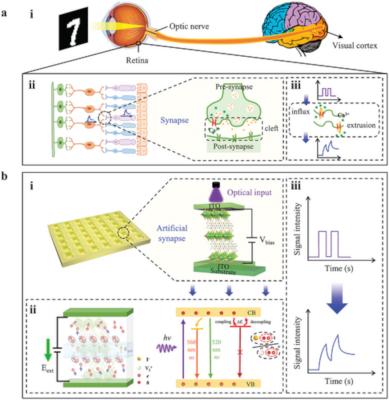Much research work is put into emulating the human vision system, that can effortlessly and efficiently interpret the visual world despite the barrage of fragmented data that strikes the retina. Neuromorphic visual sensors (NVS) based on photonic synapses hold great promise towards that end, but current photonic synapses rely on delicate engineering of the complex heterogeneous interface to realize learning and memory functions, resulting in high fabrication costs, reduced reliability, high energy consumption and uncompact architecture, severely limiting the up-scaled manufacture, and on-chip integration.
The concept of an artificial visual system mimicking the biological system. a) The biological visual system consisting of the retina (receiving and preprocessing), optic nerves (transmitting), and the visual center (processing and memory system) and a multilayer structure of a retina. b) The artificial visual system based on a 2T vertical photodetector of ITO/(BA)2PbI4/ITO. The exciton-ion coupling is responsible for the nonvolatile photocurrent. Image from Advanced Materials
Now, researchers at Nanjing Normal University, Beijing University of Posts and Telecommunications and RMIT University have reported a nanomaterials-based approach using solution grown hybrid organic-inorganic perovskites (OIHP) that intrinsically unites both photodetection and dynamic, adaptive synaptic signal modulation within single micron scale elements.
The perovskite-based synapses can better mimic human retina functionality, offering new efficiencies in AI vision systems. These synapses combine photodetection and synaptic signal modulation at the micron scale, enabling advanced image processing. The technology may significantly reduce the computational overhead and energy consumption in AI systems.
Exploiting unique photoconductive processes related to mobile ions and coupled excitons in crystalline OIHP films reportedly avoids much of the elaborate engineering needed for emulating neuronal behaviors like paired pulse facilitation or spike timing dependent plasticity using traditional electronic components. The innate photonics more closely reflects the concurrent perception, memory and adaptation found in the retina's interlinked photoreceptors and horizontal cells.
In their recent study, the research team reports a novel photodetector employing monolithic 2D hybrid organic-inorganic perovskites (OIHPs) as the central active material to replicate complex synaptic characteristics.
In mammals, information enters the brain through sensory neurons tuned to respond to stimuli like light, sound, or touch. The researchers' photo-sensitive synaptic mimic can similarly detect light signals while simultaneously modeling key synapse behaviors like paired pulse facilitation, spike-dependent plasticity, and memory formation.
By integrating perception and information processing into a single system, the device architecture closely follows the brain's fundamental structure. Additionally, the team showed their synaptic photodetector enabled critical perception and learning functions when wired into an artificial neural network. The significant performance enhancements could enable new classes of brain-inspired technologies while also shedding light on biological intelligence.
Previous efforts to develop artificial synapses for neuromorphic computing required elaborate multi-component constructions to induce the carrier trapping, localization, and gradual release dynamics necessary for memory and learning. In contrast, the researchers found that mixed ionic-electronic conductivity and strong exciton-ion coupling intrinsic to low dimensional OIHP crystals was sufficient to establish persistent non-volatile photoconductivity without requiring extensive nanoengineering.
Within the crystalline lattice, mobile positive vacancy defects and negative ions can redistribute in response to external stimuli, creating internal polarization fields that influence the retention and recombination of excitons. Expert tailoring of heterojunctions that normally underpins artificial synapse designs is thus unnecessary.
The team showed that simple two-terminal photodetectors fabricated by sandwiching crystals between ITO electrodes exhibited a host of neuron-like responses when subjected to patterned light pulses.
Besides detecting optical signals, the linearly scaled photocurrent persisted for nearly 90 seconds after illumination ceased, providing a continually variable memory trace. Pulsed illumination yielded analogues of short- and long-term synaptic potentiation based on tuning pulse number, width, intensity and interval. In particular, a paired pulse facilitation index of 126% confirmed the device's ability to replicate key mechanisms thought critical for sensory processing.
Going beyond mimicking isolated synapse functionality, the researchers demonstrated image sensing, filtering and pattern recognition using synaptic photodetector arrays interfaced with basic neural networks. Exposing the synapse mimics to handwritten numerical digit images with added noise gave differential photocurrent decay rates that preferentially enhanced image contrast and foreground detail against the background when monitored for moderate durations.
Feeding the clarified preprocessed images into a shallow neural network classifier yielded around fourfold accuracy gains overusing the raw noisy images. The nonlinear activation dynamics endowed by exciton-ion coupling allowed implementing rudimentary perception and decision making even absent the neural network. Simply monitoring the observation-history-dependent conduction states in selected photodetectors enabled recognizing facial identities from a prelearned training set with approximately 90% accuracy.
The results illustrate how the reported perovskite synapse devices could lead to next generation image sensors with built-in neural processing akin to the retina. Advancements in manufacturing scalable arrays of the crystalline films using proven coating techniques may eventually allow mass production of low-cost neuromorphic vision systems.
Implanting human brain-like sensory data interpretation directly into electronic image capturing hardware promises to slash the computational overhead and energy consumption associated with shuttling raw data to and from the cloud for storage or analysis in traditional architectures.
Importantly, besides achieving key metrics like memory lifetime, low energy operation and voltage tunability comparable with other emerging technologies, the researchers' strategy of distilling synaptic functions down to bedrock exciton-lattice interactions has conceptual implications for hand designed artificial intelligence.
By demonstrating a credible step towards artificial systems that integrate perception and intelligence using biogenic computation, this research opens the door to qualitatively expanding machine learning's scope.




